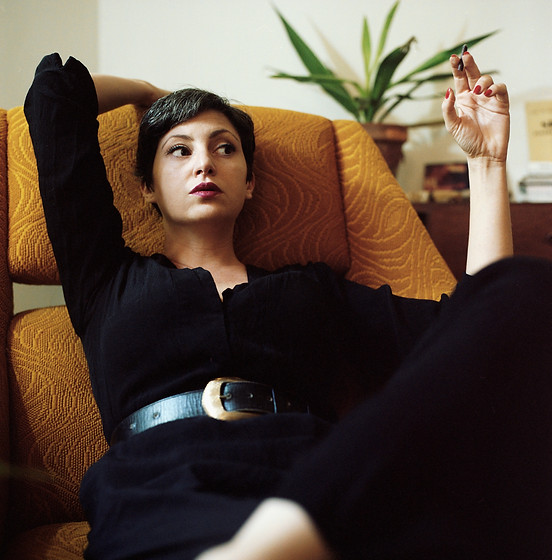

SCHEHERAZADE
Solo Show by Charlie Cauchi
December 13 2019 - February 14 2020
Portrait of Charlie Cauchi by Alexandra Pace and Scheherazade event poster design by Emma Fsadni
Welcome to 1970s Soho. Welcome to the Scheherazade nightclub where everything is for sale. Step right up for an evening of debauchery, of beauty, of brutality and an introduction to a Maltese criminal underworld that makes bank from bodies.
For her solo show at Valletta Contemporary, artist Charlie Cauchi drew from the histories of a violent episode in London’s club scene, where Maltese vice bosses laid on entertainment for partygoers that came at a high price for those entangled in its production. As a London-born woman of Maltese descent, Cauchi has woven stories of Maltese migration and the role of female protagonists in a male world of organised crime into a number of previous works, but Scheherazade represents the largest scale examination of this to date.
Like much of Cauchi’s artistic practice, Scheherazade begins with historic fact. The Scheherazade nightclub was a real place. This Maltese-owned London venue, one of many that operated in the UK’s capital between the 1940s and the 1980s, was eventually raided by Scotland Yard and closed down. According to newspaper headlines at the time, every patron, bartender, stripper and band member was taken into custody, and the dramatic episode marked the beginning of the end for Maltese gangs in London. Abstracted and reimagined as a life-size maquette of power structures, Cauchi’s Scheherazade is a compilation of seedy nightclub tropes that weigh the balance of glamour and the ugly reality of mob-run nightlife. Here, the trappings of power and money are set beside stories of migration and inequality, criminal impunity and female vulnerability.
Like its literary namesake, this Scheherazade is a fiction, but reframes a rich narrative of historic truth where women were expendable merchandise, while men sank to the depths of immorality as they climbed to the top. This vertical scale, present in Cauchi’s installation both architecturally and socially, incorporates sculptural work, video and photography as an immersive experience, and is spatially organised to draw the observer in from street level and down to the lowest gallery tier. Bathed in red light, its edges softened underfoot with scarlet carpet and horrors obscured by blood-red velvet drapes, the show is tactile, glossy, titillating and disconcerting. Altogether, ten individual works pull together as a whole scenography to describe and suggest real events and scenarios.

Scheherazade Exhibition Installation View December 2019 - February 2020, Photos by Norbert Attard and Semih Okmen
Visible from the gallery’s entrance is a projection of dancing girl to entice you in, while beneath her, lightboxes recalling 70s club signage bear lurid newspaper headlines. An expanse of red carpeting announces Here you can look at vice without soiling your fingers, sharing the space with Get ‘Em Off - a set of shifting lenticular prints that offer a shimmering mirage from the past. Through archival photographs, Cauchi reanimates strippers and dancing girls to present a fleeting look behind the curtain. Amid violence, crime and shadowy business deals, the show must go on.
Downstairs, Hells provides a window into this underworld in the form of a video installation. It is another reveal, this time representing the underground engine room driving the whole vice machine. In black and white footage, henchmen play cards, passing the time until their orders arrive. Sculpture is present in the form of Souris. A red velvet sofa recalling period club furniture, on a grotesquely distorted scale. Referencing the nickname of a prostitute working for the Messina brothers, the mouse is passive and usable but her presence is impossible to ignore.
Perhaps the most poignant sculptural pieces in Scheherazade is Berfel/Berfilni - a bed installed in the centre of the largest gallery volume. The artist’s handwriting is painstakingly hand-stitched in golden thread across a pink bedspread, representing a personal meditation on the illusion of wealth, of age, and on disposable women in a male world. I’m just history now is the lament of a prostitute reaching middle age, scrawled across her place of work. On the wall behind, Mrs Mizzi et al. is a series of brass rails hung with vintage stockings in black and beige. As an abstracted bedstead form, the stockings represent the feminine, the enticing, and the stripped, but also allude to the murder of the young Mrs Mizzi - and other prostitutes like her - who were strangled with their own stockings by the pimps who used them for financial gain.
The male experience in the vice trade is expressed through the piece Purple Hearts which faces Berfel/Berfilni as if balancing the two worlds. A tiled bathhouse space containing benches where the visitor can sit becomes a stressful several minutes as the disorienting flicker of a strobe light translates the rush of drug use. Gang members regularly visited London bathhouses in the early mornings to steam away an evening’s business and strengthen connections, still revved-up on speed.
Finally, the visitor encounters Tall-Boy, an installation of two large landscape photographic prints stretched on canvas. Arranged like tombstones in a black-carpeted room, they partially depict the lifeless body of a young black male on a mortuary table. It is the final destination and a sobering confrontation with the most horrifying aspect to this profitable trade in pleasure.
This project is supported by Arts Council Malta.
Text courtesy of Holly Knowles
Charlie Cauchi is a published researcher, producer, artist and filmmaker. Her recent work includes Latitude 36, (part of the 2018 European Capital of Culture programme) and Sempre Viva (2018).
Charlie has produced a number of short films and is currently producing and directing a feature length documentary.














